Papers by Loukas G Astrakas

Pediatric radiology, Jan 16, 2016
There is evidence of microstructural changes in normal-appearing white matter of patients with tu... more There is evidence of microstructural changes in normal-appearing white matter of patients with tuberous sclerosis complex. To evaluate major white matter tracts in children with tuberous sclerosis complex using tract-based spatial statistics diffusion tensor imaging (DTI) analysis. Eight children (mean age ± standard deviation: 8.5 ± 5.5 years) with an established diagnosis of tuberous sclerosis complex and 8 age-matched controls were studied. The imaging protocol consisted of T1-weighted high-resolution 3-D spoiled gradient-echo sequence and a spin-echo, echo-planar diffusion-weighted sequence. Differences in the diffusion indices were evaluated using tract-based spatial statistics. Tract-based spatial statistics showed increased axial diffusivity in the children with tuberous sclerosis complex in the superior and anterior corona radiata, the superior longitudinal fascicle, the inferior fronto-occipital fascicle, the uncinate fascicle and the anterior thalamic radiation. No signifi...
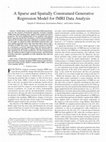
Ieee Transactions on Biomedical Engineering, 2012
In this study, we present an advanced Bayesian framework for the analysis of functional magnetic ... more In this study, we present an advanced Bayesian framework for the analysis of functional magnetic resonance imaging (fMRI) data that simultaneously employs both spatial and sparse properties. The basic building block of our method is the general linear regression model that constitutes a well-known probabilistic approach. By treating regression coefficients as random variables, we can apply an enhanced Gibbs distribution function that captures spatial constrains and at the same time allows sparse representation of fMRI time series. The proposed scheme is described as a maximum a posteriori approach, where the known expectation maximization algorithm is applied offering closed-form update equations for the model parameters. We have demonstrated that our method produces improved performance and functional activation detection capabilities in both simulated data and real applications.

European radiology, Jan 16, 2015
The aim was to determine the proton MR (1H-MR) spectra of normal adult testes and variations with... more The aim was to determine the proton MR (1H-MR) spectra of normal adult testes and variations with age. Forty-one MR spectra of normal testes, including 16 testes from men aged 20-39 years (group I) and 25 testes from men aged 40-69 years (group II), were analyzed. A single-voxel point-resolved spectroscopy sequence (PRESS), with TR/TE: 2000/25 ms was used. The volume of interest was placed to include the majority of normal testicular parenchyma. Association between normalized metabolite concentrations, defined as ratios of the calculated metabolite concentrations relative to creatine concentration, and age was assessed. Quantified metabolites of the spectra were choline (Cho), creatine (Cr), myo-inositol (mI), scyllo-inositol, taurine, lactate, GLx compound, glucose, lipids, and macromolecules resonating at 0.9 ppm (LM09), around 20 ppm (LM20), and at 13 ppm (LM13). Most prominent peaks were Cho, Cr, mI, and lipids. A weak negative correlation between mI and age (P = 0.015) was obse...

European Journal of Radiology, 2015
The aim of this study is to investigate the role of apparent diffusion coefficient (ADC) values a... more The aim of this study is to investigate the role of apparent diffusion coefficient (ADC) values and dynamic contrast enhancement (DCE) patterns in differentiating seminomas from nonseminomatous germ cell tumors (NSGCTs). The MRI examinations of the scrotum of 26 men with histologically proven testicular GCTs were reviewed. DWI was performed in all patients, using a single shot, multi-slice spin-echo planar diffusion pulse sequence and b-values of 0 and 900s/mm(2). Subtraction DCE-MRI was performed in 20 cases using a 3D fast-field echo sequence after gadolinium administration. Time-signal intensity curves were created and semi-quantitative parameters (peak enhancement, time to peak, wash-in and wash-out rate) were calculated. The Student's t-test was used to compare the mean values of ADC, peak enhancement, time to peak, wash-in and wash-out rate between seminomas and NSGCTs. ROC analysis was also performed. Histopathology disclosed the presence of 15 seminomas and 11 NSGCTs. The mean±s.d. of ADC values (×10(-3)mm(2)/s) of seminomas (0.59±0.009) were significantly lower than those of NSGCTs (0.90±0.33) (P=0.01). The optimal ADC cut-off value was 0.68×10(-3)mm(2)/s. No differences between the two groups were observed for peak enhancement (P=0.18), time to peak (P=0.63) wash-in rate (P=0.32) and wash-out rate (P=0.18). ADC values may be used to preoperatively differentiate seminomas from NSGCTs.
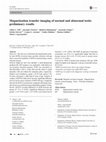
European Radiology, 2015
Objectives The aim was to determine the magnetization transfer ratio (MTR) of normal testes, poss... more Objectives The aim was to determine the magnetization transfer ratio (MTR) of normal testes, possible variations with age and to assess the feasibility of MTR in characterizing various testicular lesions. Methods Eighty-six men were included. A three-dimensional gradient-echo MT sequence was performed, with/without an on-resonance binomial prepulse. MTR was calculated as: (SIo-SIm)/(SIo)×100 %, where SIm and SIo refers to signal intensities with and without the saturation pulse, respectively. Subjects were classified as: group 1, 20-39 years; group 2, 40-65 years; and group 3, older than 65 years of age. Analysis of variance (ANOVA) followed by the least significant difference test was used to assess variations of MTR with age. Comparison between the MTR of normal testis, malignant and benign testicular lesions was performed using independent-samples t testing.

International Journal of Neuroscience, 2015
The multimodal imaging investigation of excessive daytime sleepiness (EDS) in Parkinson&a... more The multimodal imaging investigation of excessive daytime sleepiness (EDS) in Parkinson's disease (PD). The role of dopaminergic treatment and other clinical parameters was also evaluated. Seventeen non-demented PD patients with EDS (PD-EDS) and 17 PD patients without EDS were enrolled. Clinical, treatment and MRI data were acquired. Gray matter (GM) volume was examined with voxel-based morphometry, while white matter (WM) integrity was assessed with diffusion tensor imaging by means of fractional anisotropy, mean diffusivity, axial diffusivity (AD) and radial diffusivity measures. Increased regional GM volume was found in the PD-EDS group bilaterally in the hippocampus and parahippocampal gyri. Increased AD values were also shown in the PD-EDS group, in the left anterior thalamic radiation and the corticospinal tract and bilaterally in the superior corona radiata and the superior longitudinal fasciculus. Levodopa equivalent dose differed significantly between the groups and was the only predictor of EDS, while the only predictor of the Epworth sleepiness scale score in the PD-EDS group was the dopamine-agonist dose. Increased frequency of gamblers was also observed in the PD-EDS group. Regional GM increases and increased AD values in certain WM tracts were found in the PD-EDS group. The changes could result from disinhibited signaling pathways or represent compensatory changes in response to anatomical or functional deficits elsewhere. The study findings support also the contribution of the total dopaminergic load in the development of EDS, while the dose of dopamine agonists was found to predict the severity of the disorder.
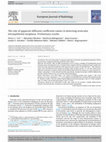
European journal of radiology, Jan 21, 2015
The aim of this study is to improve detection of testicular intraepithelial neoplasia (TIN) by me... more The aim of this study is to improve detection of testicular intraepithelial neoplasia (TIN) by measurement of apparent diffusion coefficient (ADC) values. Fifty-six MRI examinations of the scrotum, including 26 histologically proven testicular germ cell neoplasms were retrospectively evaluated. DWI was performed using a single shot, multi-slice spin-echo planar diffusion pulse sequence and b-values of 0 and 900smm(-2). ADC measurements were classified into three groups according to their location: group 1 (n=19), non-tumoral part, adjacent to testicular carcinoma, where the possible location of TIN was; group 2 (n=26), testicular carcinoma; and group 3 (n=60), normal testicular parenchyma. Analysis of variance (ANOVA) followed by post hoc analysis (Dunnett T3) was used for statistical purposes. The mean±s.d. of ADC values (×10(-3)mm(2)/s) of different groups were: group 1, 1.08±0.20; group 2, 0.72±0.27; and group 3, 1.11±0.14. ANOVA revealed differences of mean ADC between groups (F...
Tumors of the Central Nervous System, 2013
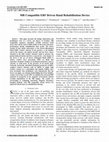
9th International Conference on Rehabilitation Robotics, 2005. ICORR 2005., 2005
This paper presents the design, fabrication and preliminary tests of a novel, one degree of freed... more This paper presents the design, fabrication and preliminary tests of a novel, one degree of freedom, MR compatible, computer controlled, variable resistance hand device that will be used in fMRI studies of the brain and motor performance during rehabilitation after stroke. The device consists of four major subsystems: a) the Electro-Rheological Fluid (ERF) resistive element; b) the gearbox; c) the handles and d) the sensors: one optical encoder and one force sensor attached to the ERF resistive element's shaft to measure the patient induced motion and force, respectively. A key feature of the device is the use of electro rheological fluids (ERF) to achieve resistive force generation. ERFs are fluids that experience dramatic changes in rheological properties, such as viscosity or yield stress, in the presence of an electric field. Using the electrically controlled rheological properties of ERFs, compact resistive elements with an ability to supply high resistive torques in a controllable and tunable fashion, have been developed. Our preliminary tests demonstrate that the device can apply, on a human hand holding the device handles, resistive forces that exceed 150N. In addition the activated ERF maintain its properties in the magnetic environment without creating degradation of the MR images. The results are encouraging in combining functional Magnetic Resonance Imaging methods, with MR compatible robotic devices for improved effectiveness of rehabilitation therapy.

European Radiology, 2014
To investigate structural brain changes in inflammatory bowel disease (IBD). Brain magnetic reson... more To investigate structural brain changes in inflammatory bowel disease (IBD). Brain magnetic resonance imaging (MRI) was performed on 18 IBD patients (aged 45.16 ± 14.71 years) and 20 aged-matched control subjects. The imaging protocol consisted of a sagittal-FLAIR, a T1-weighted high-resolution three-dimensional spoiled gradient-echo sequence, and a multisession spin-echo echo-planar diffusion-weighted sequence. Differences between patients and controls in brain volume and diffusion indices were evaluated using the voxel-based morphometry (VBM) and tract-based spatial statistics (TBSS) methods, respectively. The presence of white-matter hyperintensities (WMHIs) was evaluated on FLAIR images. VBM revealed decreased grey matter (GM) volume in patients in the fusiform and the inferior temporal gyrus bilaterally, the right precentral gyrus, the right supplementary motor area, the right middle frontal gyrus and the left superior parietal gyrus (p < 0.05). TBSS showed decreased axial diffusivity (AD) in the right corticospinal tract and the right superior longitudinal fasciculus in patients compared with controls. A larger number of WMHIs was observed in patients (p < 0.05). Patients with IBD show an increase in WMHIs and GM atrophy, probably related to cerebral vasculitis and ischaemia. Decreased AD in major white matter tracts could be a secondary phenomenon, representing Wallerian degeneration. • There is evidence of central nervous system involvement in IBD. • Diffusion tensor imaging detects microstructural brain abnormalities in IBD. • Voxel based morphometry reveals brain atrophy in IBD.

International Journal of Molecular Medicine, 2006
Burn trauma is a clinical condition accompanied by muscle wasting that severely impedes rehabilit... more Burn trauma is a clinical condition accompanied by muscle wasting that severely impedes rehabilitation in burn survivors. Mitochondrial uncoupling protein 3 (UCP3) is uniformly expressed in myoskeletal mitochondria and its expression has been found to increase in other clinical syndromes that, like burn trauma, are associated with muscle wasting (e.g., starvation, fasting, cancer, sepsis). The aim of this study was to explore the effects of burn trauma on UCP3 expression, intramyocellular lipids, and plasma-free fatty acids. Mice were studied at 6 h, 1 d and 3 d after nonlethal hindlimb burn trauma. Intramyocellular lipids in hindlimb skeletal muscle samples collected from burned and normal mice were measured using 1H NMR spectroscopy on a Bruker 14.1 Tesla spectrometer at 4 degrees C. UCP3 mRNA and protein levels were also measured in these samples. Plasma-free fatty acids were measured in burned and normal mice. Local burn trauma was found to result in: 1) upregulation of UCP3 mRNA and protein expression in hindlimb myoskeletal mitochondria by 6 h postburn; 2) increased intramyocellular lipids; and 3) increased plasma-free fatty acids. Our findings show that the increase in UCP3 after burn trauma may be linked to burn-induced alterations in lipid metabolism. Such a link could reveal novel insights into how processes related to energy metabolism are controlled in burn and suggest that induction of UCP3 by burn in skeletal muscle is protective by either activating cellular redox signaling and/or mitochondrial uncoupling.

International Journal of Molecular Medicine, 2008
Using a mouse model of burn trauma, we tested the hypothesis that severe burn trauma correspondin... more Using a mouse model of burn trauma, we tested the hypothesis that severe burn trauma corresponding to 30% of total body surface area (TBSA) causes reduction in adenosine triphosphate (ATP) synthesis in distal skeletal muscle. We employed in vivo 31P nuclear magnetic resonance (NMR) in intact mice to assess the rate of ATP synthesis, and characterized the concomitant gene expression patterns in skeletal muscle in burned (30% TBSA) versus control mice. Our NMR results showed a significantly reduced rate of ATP synthesis and were complemented by genomic results showing downregulation of the ATP synthase mitochondrial F1 F0 complex and PGC-1beta gene expression. Our findings suggest that inflammation and muscle atrophy in burns are due to a reduced ATP synthesis rate that may be regulated upstream by PGC-1beta. These findings implicate mitochondrial dysfunction in distal skeletal muscle following burn injury. That PGC-1beta is a highly inducible factor in most tissues and responds to common calcium and cyclic adenosine monophosphate (cAMP) signaling pathways strongly suggests that it may be possible to develop drugs that can induce PGC-1beta.

Medical Physics, 2016
Independent component analysis (ICA) is an established method of analyzing human functional MRI (... more Independent component analysis (ICA) is an established method of analyzing human functional MRI (fMRI) data. Here, an ICA-based fMRI quality control (QC) tool was developed and used. ICA-based fMRI QC tool to be used with a commercial phantom was developed. In an attempt to assess the performance of the tool relative to preexisting alternative tools, it was used seven weeks before and eight weeks after repair of a faulty gradient amplifier of a non-state-of-the-art MRI unit. More specifically, its performance was compared with the AAPM 100 acceptance testing and quality assurance protocol and two fMRI QC protocols, proposed by Freidman et al. ["Report on a multicenter fMRI quality assurance protocol," J. Magn. Reson. Imaging 23, 827-839 (2006)] and Stocker et al. ["Automated quality assurance routines for fMRI data applied to a multicenter study," Hum. Brain Mapp. 25, 237-246 (2005)], respectively. The easily developed and applied ICA-based QC protocol provided fMRI QC indices and maps equally sensitive to fMRI instabilities with the indices and maps of other established protocols. The ICA fMRI QC indices were highly correlated with indices of other fMRI QC protocols and in some cases theoretically related to them. Three or four independent components with slow varying time series are detected under normal conditions. ICA applied on phantom measurements is an easy and efficient tool for fMRI QC. Additionally, it can protect against misinterpretations of artifact components as human brain activations. Evaluating fMRI QC indices in the central region of a phantom is not always the optimal choice.

International journal of oncology, 2007
Using brain proton magnetic resonance spectroscopic imaging (MRSI) in children with central nervo... more Using brain proton magnetic resonance spectroscopic imaging (MRSI) in children with central nervous system (CNS) tumors, we tested the hypothesis that combining information from biologically important metabolites, at diagnosis and prior to treatment, would improve prediction of survival. We evaluated brain proton MRSI exams in 76 children (median age at diagnosis: 74 months) with brain tumors. Important biomarkers, choline-containing compounds (Cho), N-acetylaspartate (NAA), total creatine (tCr), lipids and/or lactate (L), were measured at the "highest Cho region" and normalized to the tCr of surrounding healthy tissue. Neuropathological grading was performed using World Health Organization (WHO) criteria. Fifty-eight of 76 (76%) patients were alive at the end of the study period. The mean survival time for all subjects was 52 months. Univariate analysis demonstrated that Cho, L, Cho/NAA and tumor grade differed significantly between survivors and non-survivors (P< or =...
Physical Review B, 1998
B 2 O 3 in glass and crystalline states have been subjected to gamma irradiation at room temperat... more B 2 O 3 in glass and crystalline states have been subjected to gamma irradiation at room temperature and subsequently studied by continuous-wave electron paramagnetic resonance and electron-spin-echo envelope modulation (ESEEM) spectroscopy at liquid-helium ...
Diagnostic Techniques and Surgical Management of Brain Tumors, 2011
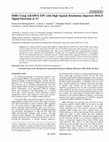
The Open Magnetic Resonance Journal, 2009
We compared GRAPPA parallel MRI (pMRI) to regular MRI (non-GRAPPA) for BOLD fMRI while keeping al... more We compared GRAPPA parallel MRI (pMRI) to regular MRI (non-GRAPPA) for BOLD fMRI while keeping all other parameters fixed. We acquired both GRAPPA and non-GRAPPA images using a high resolution as well as a low resolution EPI matrix. We found significantly larger values of percent BOLD signal when comparing higher resolution acquisitions to lower resolution ones, independently of whether data were acquired with GRAPPA EPI or with regular EPI. We also demonstrated no loss of functional activation or BOLD signal when comparing GRAPPA to non-GRAPPA while keeping the same spatial resolution. We propose to use pMRI to gain the ability to perform whole-brain acquisition at higher spatial resolution with TE in the 30-40 ms range for optimal BOLD detection at 3T, or at faster scan times. To this end, we conclude that GRAPPA pMRI is advantageous for BOLD fMRI and whole-brain EPI acquisition at high spatial resolution.
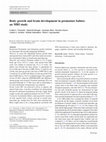
Pediatric Radiology
Prematurity and intrauterine growth restriction are associated with neurodevelopmental disabiliti... more Prematurity and intrauterine growth restriction are associated with neurodevelopmental disabilities. To assess the relationship between growth status and regional brain volume (rBV) and white matter microstructure in premature babies at around term-equivalent age. Premature infants (n= 27) of gestational age (GA): 29.8 ± 2.1 weeks, with normal brain MRI scans were studied at corrected age: 41.2 ± 1.4 weeks. The infants were divided into three groups: 1) appropriate for GA at birth and at the time of MRI (AGA), 2) small for GA at birth with catch-up growth at the time of MRI (SGAa) and 3) small for GA at birth with failure of catch-up growth at the time of MRI (SGAb). The T1-weighted images were segmented into 90 rBVs using the SPM8/IBASPM and differences among groups were assessed. Fractional anisotropy (FA) was measured bilaterally in 15 fiber tracts and its relationship to GA and somatometric measurements was explored. Lower rBV was observed in SGAb in superior and anterior brain ...
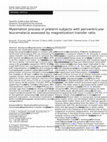
Pediatric Radiology, 2006
Background: Magnetization transfer imaging assesses the myelination status of the brain. Objectiv... more Background: Magnetization transfer imaging assesses the myelination status of the brain. Objectives: To study the progress of myelination in children with periventricular leucomalacia (PVL) by measuring the magnetization transfer ratio (MTR) and to compare the MTR values with normal values. Materials and methods: Brain MTR in 28 PVL subjects (16 males, 12 females, gestational age 30.7±2.5 weeks, corrected age 3.1±2.9 years) was measured using a 3D gradient echo sequence (TR/TE 32/8 ms, flip angle 60°, 4 mm/2 mm overlapping sections) without and with magnetization transfer prepulse and compared with normal values for preterm subjects. Results: MTR of white-matter structures followed a monoexponential function model (y=A−B*exp(−x/C)) while the thalamus and caudate nucleus had a poor goodness of fit. MTR of the splenium of the corpus callosum reached a final value lower than normal (0.67 versus 0.70) at a younger age [t(99%) at 10.32 versus 18.90 months; P<0.05]. MTR of the normalappearing occipital white matter and of the genu of the corpus callosum reached a normal final MTR but at a younger age than normal preterm infants [t(99%) at 8.51 versus 14.50 months and 12.51 versus 20.85 months, respectively]. Conclusion: In PVL subjects, myelination of the splenium is characterized by early arrest and deficient maturation. Accelerated myelination in unaffected white matter might suggest a compensatory process of reorganization.






Uploads
Papers by Loukas G Astrakas